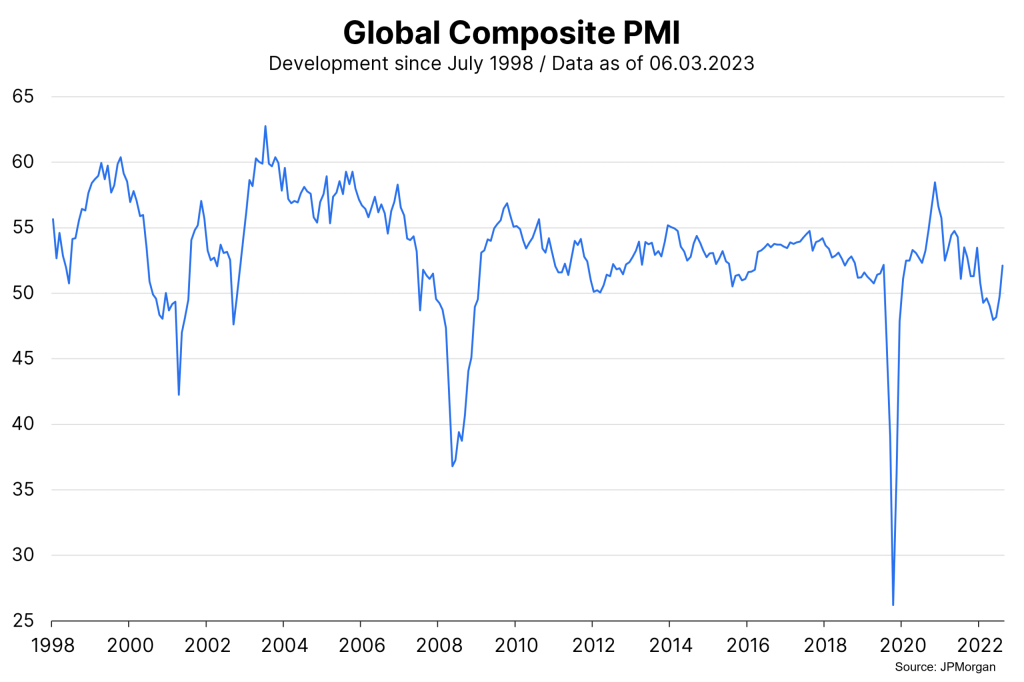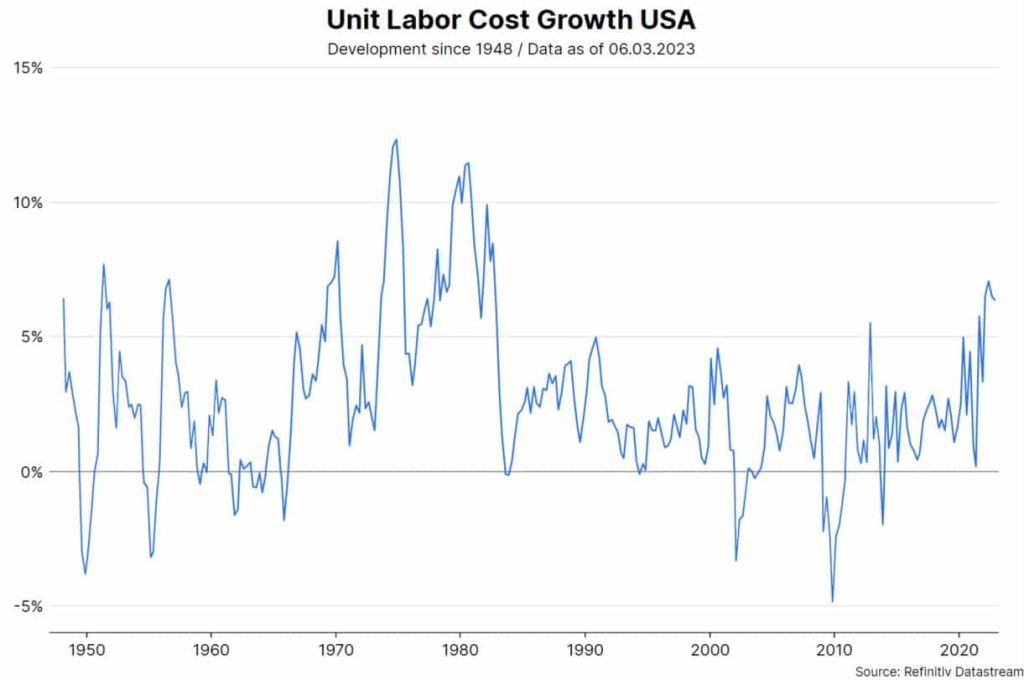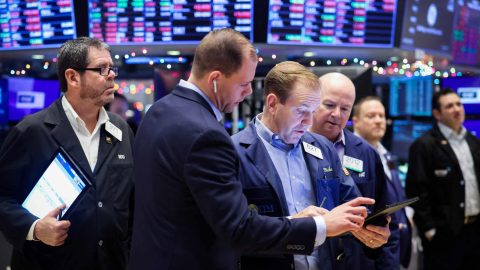The indications for an increase in global real economic growth have increased in recent days. With the global purchasing managers index, one of the most important survey-based economic reports has been published. The overall number showed an increase for the third consecutive month for the month of February, with the increase accelerating.
If this positive economic data were taking place in a low inflation environment, it would be unqualified good news. However, inflation reports have been published at the same time, further dampening hopes for a rapid decline in inflation without additional key rate hikes.
Trend growth
With a value of 52.1, the Purchasing Managers’ Index (PMI) points to global growth around potential (2.5% quarterly growth annualized). The rising trend (positive momentum), the improvement in new orders as well as the expectations component even point to higher growth for the coming months.

Broad-based increase
Also impressive is that both manufacturing and services participated in the increase. Thus, global manufacturing may have grown in the first quarter after contracting in the fourth quarter. The larger increase in the services PMI suggests that there is still pent-up demand toward the end of the pandemic. The strong increase in the overall number was driven in good part by the strong increase in the PMI in China. This confirmed the expectation for a V-shaped (rapid) recovery after the abandonment of the zero tolerance policy toward new infections. Overall, however, most countries showed an increase.
Solid labor market
This improvement in economic indicators is taking place while unemployment rates are very low. In the Eurozone, the unemployment rate in January was only 6.7% (a very low value). Next Friday, the unemployment rate in the USA is expected to be 3.4% in the month of February (also very low). Regarding employment (Nonfarm Payrolls), an increase of 215,000 is expected. The previous month was super strong at over 500,000. The increase in the employment component of the Purchasing Managers Report for the second month in a row points to a continued firm labor market.
High inflation
On the inflation side, however, there is disappointing news. In the U.S., the second estimate of unit labor cost growth for the fourth quarter of 2022 was revised sharply upward (first estimate: 4.3% y/y, second estimate: 6.5%). All components involved were moved in the “wrong” direction. Output down (0.7% y/y), hours worked up (2.6%), hourly wages up (4.4%). Unit labor cost growth has a significant impact on consumer price inflation.
In the eurozone, the flash estimate for consumer price inflation in the month of February showed a surprisingly strong increase of 0.7% month-on-month and 8.5% year-on-year. The core rate (excluding the volatile food and energy components) was also high at 0.7% y/y and 5.6% y/y. In addition, in the global purchasing managers’ index, selling prices did not continue the falling trend in February.

Important secondary condition
The rising economic indicators are only conditionally positive: The important condition is that inflation falls quickly. However, the most recently published inflation indicators point in the opposite direction (persistence). This has reduced the scope for central banks to pause in order to better assess the effect of key rate hikes on growth and inflation. A key interest rate in the USA of 6% (upper band) and of 4% (lower band) in the euro zone has become more likely. In this environment, Fed Chairman Jerome Powell’s speeches to two congressional committees today Tuesday and tomorrow Wednesday will be closely watched.
For a glossary of technical terms, please visit this link: Fund Glossary | Erste Asset Management
Legal note:
Prognoses are no reliable indicator for future performance.
Legal disclaimer
This document is an advertisement. Unless indicated otherwise, source: Erste Asset Management GmbH. The language of communication of the sales offices is German and the languages of communication of the Management Company also include English.
The prospectus for UCITS funds (including any amendments) is prepared and published in accordance with the provisions of the InvFG 2011 as amended. Information for Investors pursuant to § 21 AIFMG is prepared for the alternative investment funds (AIF) administered by Erste Asset Management GmbH pursuant to the provisions of the AIFMG in conjunction with the InvFG 2011.
The currently valid versions of the prospectus, the Information for Investors pursuant to § 21 AIFMG, and the key information document can be found on the website www.erste-am.com under “Mandatory publications” and can be obtained free of charge by interested investors at the offices of the Management Company and at the offices of the depositary bank. The exact date of the most recent publication of the prospectus, the languages in which the fund prospectus or the Information for Investors pursuant to Art 21 AIFMG and the key information document are available, and any other locations where the documents can be obtained are indicated on the website www.erste-am.com. A summary of the investor rights is available in German and English on the website www.erste-am.com/investor-rights and can also be obtained from the Management Company.
The Management Company can decide to suspend the provisions it has taken for the sale of unit certificates in other countries in accordance with the regulatory requirements.
Note: You are about to purchase a product that may be difficult to understand. We recommend that you read the indicated fund documents before making an investment decision. In addition to the locations listed above, you can obtain these documents free of charge at the offices of the referring Sparkassen bank and the offices of Erste Bank der oesterreichischen Sparkassen AG. You can also access these documents electronically at www.erste-am.com.
Our analyses and conclusions are general in nature and do not take into account the individual characteristics of our investors in terms of earnings, taxation, experience and knowledge, investment objective, financial position, capacity for loss, and risk tolerance. Past performance is not a reliable indicator of the future performance of a fund.
Please note: Investments in securities entail risks in addition to the opportunities presented here. The value of units and their earnings can rise and fall. Changes in exchange rates can also have a positive or negative effect on the value of an investment. For this reason, you may receive less than your originally invested amount when you redeem your units. Persons who are interested in purchasing units in investment funds are advised to read the current fund prospectus(es) and the Information for Investors pursuant to § 21 AIFMG, especially the risk notices they contain, before making an investment decision. If the fund currency is different than the investor’s home currency, changes in the relevant exchange rate can positively or negatively influence the value of the investment and the amount of the costs associated with the fund in the home currency.
We are not permitted to directly or indirectly offer, sell, transfer, or deliver this financial product to natural or legal persons whose place of residence or domicile is located in a country where this is legally prohibited. In this case, we may not provide any product information, either.
Please consult the corresponding information in the fund prospectus and the Information for Investors pursuant to § 21 AIFMG for restrictions on the sale of the fund to American or Russian citizens.
It is expressly noted that this communication does not provide any investment recommendations, but only expresses our current market assessment. Thus, this communication is not a substitute for investment advice.
This document does not represent a sales activity of the Management Company and therefore may not be construed as an offer for the purchase or sale of financial or investment instruments.
Erste Asset Management GmbH is affiliated with the Erste Bank and austrian Sparkassen banks.
Please also read the “Information about us and our securities services” published by your bank.


